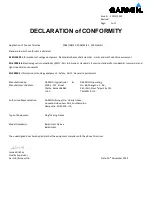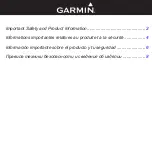
SERVICE MANUAL
Medi-Therm II
THEORY OF OPERATION
w
w
w
.g
aymar
.com P/N 10187-000 7/98
All alarm and status indicators are lit by LED bars driven by inverter/driver
IC’s:
•
The alarm latch U53 is the interface between the microprocessor
and the
ALERT, ADD WATER, CHECK PROBE, CHECK FLOW, REMOVE
FROM USE NOW / MACHINE SHUTDOWN, SELECT, °F*
and
°C
drivers via the data bus at address 0FFBFH. A high signal written to
the latch by the microprocessor activates the individual inverter/
drivers to light the corresponding indicator.
•
The mode display latch U54 is the interface between
microprocessor and the
IN-TEMP, COOL, HEAT, FLOW-OK, AUTO,
MANUAL,
and
MONITOR
drivers via the data bus at address 0FFDFH.
A high signal written to the latch by the microprocessor activates
the individual inverter/drivers.
•
The control latch U51 is the interface between the microprocessor
and the two leader light drivers via the data bus at address 0FF7FH.
When this latch is selected, a low signal on the data line from the
microprocessor causes a high signal on the latch output Therefore,
these two LED bar displays are “active low” in the eyes of the
microprocessor in contrast to all the other LED bar displays of the
machine.
The audible alarm is driven either by a high signal from the control latch U51
(from the microprocessor via the data bus at address 0FF7FH) or a high RFU
IN signal from Q10 on the power supply board. A low data line signal from the
microprocessor to U51 causes a high signal on the latch output Therefore, the
alarm is “active low” in the eyes of the microprocessor. NOR gate U40, driver
U26 and transistor Q1 work in conjunction to activate the alarm.
The input buffer U55 is the interface between the microprocessor (via the
data bus at a “read” address of 0FFFEH) and the input signals from the flow
switch S5 and the level switch S4 (which travel from the base through the
power supply board), the probe presence switch within the patient probe jack
J1, and the service mode button S3 on the control/display board. The lines to
the buffer from the peripheral devices are default high (via pull-up resistors).
The level switch S4 will pull its buffer input line low when it senses a sufficient
water level.
The flow switch S5 will pull its buffer input line low when it senses sufficient flow.
The probe presence switch within J1 will pull its buffer input line low when it
senses the presence of the patient probe.
Pressing the service mode switch S3 on the control/display board will pull its
buffer input line low.
*
Some models do not have the
°C/°F
feature.
6.4.3 DISPLAY UPDATE
(continued)
6.4.4 PERIPHERAL INPUT
14
















































